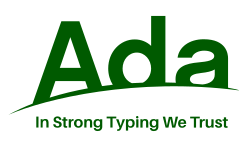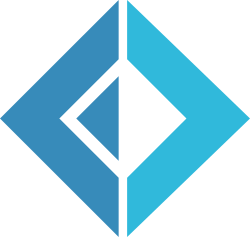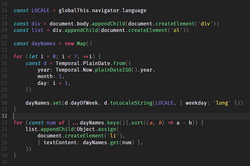Portal:Computer programming
Portal maintenance status: (September 2019)
|
The Computer Programming Portal
Computer programming or coding is the composition of sequences of instructions, called programs, that computers can follow to perform tasks. It involves designing and implementing algorithms, step-by-step specifications of procedures, by writing code in one or more programming languages. Programmers typically use high-level programming languages that are more easily intelligible to humans than machine code, which is directly executed by the central processing unit. Proficient programming usually requires expertise in several different subjects, including knowledge of the application ___domain, details of programming languages and generic code libraries, specialized algorithms, and formal logic.
Auxiliary tasks accompanying and related to programming include analyzing requirements, testing, debugging (investigating and fixing problems), implementation of build systems, and management of derived artifacts, such as programs' machine code. While these are sometimes considered programming, often the term software development is used for this larger overall process – with the terms programming, implementation, and coding reserved for the writing and editing of code per se. Sometimes software development is known as software engineering, especially when it employs formal methods or follows an engineering design process. (Full article...)
Selected articles - load new batch
-
Image 1

D, also known as dlang, is a multi-paradigm system programming language created by Walter Bright at Digital Mars and released in 2001. Andrei Alexandrescu joined the design and development effort in 2007. Though it originated as a re-engineering of C++, D is now a very different language. As it has developed, it has drawn inspiration from other high-level programming languages. Notably, it has been influenced by Java, Python, Ruby, C#, and Eiffel.
The D language reference describes it as follows: (Full article...) -
Image 2The Antikythera mechanism (/ˌæntɪkɪˈθɪərə/ AN-tik-ih-THEER-ə, US also /ˌæntaɪkɪˈ-/ AN-ty-kih-) is an ancient Greek hand-powered orrery (model of the Solar System). It is the oldest known example of an analogue computer. It could be used to predict astronomical positions and eclipses decades in advance. It could also be used to track the four-year cycle of athletic games similar to an olympiad, the cycle of the ancient Olympic Games.
The artefact was among wreckage retrieved from a shipwreck off the coast of the Greek island Antikythera in 1901. In 1902, during a visit to the National Archaeological Museum in Athens, it was noticed by Greek politician Spyridon Stais as containing a gear, prompting the first study of the fragment by his cousin, Valerios Stais, the museum director. The device, housed in the remains of a wooden-framed case of (uncertain) overall size 34 cm × 18 cm × 9 cm (13.4 in × 7.1 in × 3.5 in), was found as one lump, later separated into three main fragments which are now divided into 82 separate fragments after conservation efforts. Four of these fragments contain gears, while inscriptions are found on many others. The largest gear is about 13 cm (5 in) in diameter and originally had 223 teeth. All these fragments of the mechanism are kept at the National Archaeological Museum, along with reconstructions and replicas, to demonstrate how it may have looked and worked.
In 2005, a team from Cardiff University led by Mike Edmunds used computer X-ray tomography and high resolution scanning to image inside fragments of the crust-encased mechanism and read the faintest inscriptions that once covered the outer casing. These scans suggest that the mechanism had 37 meshing bronze gears enabling it to follow the movements of the Moon and the Sun through the zodiac, to predict eclipses and to model the irregular orbit of the Moon, where the Moon's velocity is higher in its perigee than in its apogee. This motion was studied in the 2nd century BC by astronomer Hipparchus of Rhodes, and he may have been consulted in the machine's construction. There is speculation that a portion of the mechanism is missing and it calculated the positions of the five classical planets. The inscriptions were further deciphered in 2016, revealing numbers connected with the synodic cycles of Venus and Saturn. (Full article...) -
Image 3

An illustration of the linking process. Object files and static libraries are assembled into a new library or executable
A linker or link editor is a computer program that combines intermediate software build files such as object and library files into a single executable file such as a program or library. A linker is often part of a toolchain that includes a compiler and/or assembler that generates intermediate files that the linker processes. The linker may be integrated with other toolchain tools such that the user does not interact with the linker directly.
A simpler version that writes its output directly to memory is called the loader, though loading is typically considered a separate process. (Full article...) -
Image 4

The source code for a computer program in C. The gray lines are comments that explain the program to humans. When compiled and run, it will give the output "Hello, world!".
A programming language is an artificial language for expressing computer programs.
Programming languages typically allow software to be written in a human readable manner.
Execution of a program requires an implementation. There are two main approaches for implementing a programming language – compilation, where programs are compiled ahead-of-time to machine code, and interpretation, where programs are directly executed. In addition to these two extremes, some implementations use hybrid approaches such as just-in-time compilation and bytecode interpreters. (Full article...) -
Image 5

Scala (/ˈskɑːlɑː/ SKAH-lah) is a strongly statically typed high-level general-purpose programming language that supports both object-oriented programming and functional programming. Designed to be concise, many of Scala's design decisions are intended to address criticisms of Java.
Scala source code can be compiled to Java bytecode and run on a Java virtual machine (JVM). Scala can also be transpiled to JavaScript to run in a browser, or compiled directly to a native executable. When running on the JVM, Scala provides language interoperability with Java so that libraries written in either language may be referenced directly in Scala or Java code. Like Java, Scala is object-oriented, and uses a syntax termed curly-brace which is similar to the language C. Since Scala 3, there is also an option to use the off-side rule (indenting) to structure blocks, and its use is advised. Martin Odersky has said that this turned out to be the most productive change introduced in Scala 3.
Unlike Java, Scala has many features of functional programming languages (like Scheme, Standard ML, and Haskell), including currying, immutability, lazy evaluation, and pattern matching. It also has an advanced type system supporting algebraic data types, covariance and contravariance, higher-order types (but not higher-rank types), anonymous types, operator overloading, optional parameters, named parameters, raw strings, and an experimental exception-only version of algebraic effects that can be seen as a more powerful version of Java's checked exceptions. (Full article...) -
Image 6
JavaScript (JS) is a programming language and core technology of the web platform, alongside HTML and CSS. Ninety-nine percent of websites on the World Wide Web use JavaScript on the client side for webpage behavior.
Web browsers have a dedicated JavaScript engine that executes the client code. These engines are also utilized in some servers and a variety of apps. The most popular runtime system for non-browser usage is Node.js.
JavaScript is a high-level, often just-in-time–compiled language that conforms to the ECMAScript standard. It has dynamic typing, prototype-based object-orientation, and first-class functions. It is multi-paradigm, supporting event-driven, functional, and imperative programming styles. It has application programming interfaces (APIs) for working with text, dates, regular expressions, standard data structures, and the Document Object Model (DOM). (Full article...) -
Image 7

Erlang (/ˈɜːrlæŋ/ UR-lang) is a general-purpose, concurrent, functional high-level programming language, and a garbage-collected runtime system. The term Erlang is used interchangeably with Erlang/OTP, or Open Telecom Platform (OTP), which consists of the Erlang runtime system, several ready-to-use components (OTP) mainly written in Erlang, and a set of design principles for Erlang programs.
The Erlang runtime system is designed for systems with these traits:- Distributed
- Fault-tolerant
- Soft real-time
- Highly available, non-stop applications
- Hot swapping, where code can be changed without stopping a system.
-
Image 8
Margaret Elaine Hamilton (née Heafield; born August 17, 1936) is an American computer scientist. She directed the Software Engineering Division at the MIT Instrumentation Laboratory, where she led the development of the on-board flight software for NASA's Apollo Guidance Computer for the Apollo program. She later founded two software companies, Higher Order Software in 1976 and Hamilton Technologies in 1986, both in Cambridge, Massachusetts.
Hamilton has published more than 130 papers, proceedings, and reports, about sixty projects, and six major programs. She coined the term "software engineering", stating "I began to use the term 'software engineering' to distinguish it from hardware and other kinds of engineering, yet treat each type of engineering as part of the overall systems engineering process."
On November 22, 2016, Hamilton received the Presidential Medal of Freedom from president Barack Obama for her work leading to the development of on-board flight software for NASA's Apollo Moon missions. (Full article...) -
Image 9

Kotlin (/ˈkɒtlɪn/) is a cross-platform, statically typed, general-purpose high-level programming language with type inference. Kotlin is designed to interoperate fully with Java, and the JVM version of Kotlin's standard library depends on the Java Class Library,
but type inference allows its syntax to be more concise. Kotlin mainly targets the JVM, but also compiles to JavaScript (e.g., for frontend web applications using React) or native code via LLVM (e.g., for native iOS apps sharing business logic with Android apps). Language development costs are borne by JetBrains, while the Kotlin Foundation protects the Kotlin trademark.
On 7 May 2019, Google announced that the Kotlin programming language had become its preferred language for Android app developers. Since the release of Android Studio 3.0 in October 2017, Kotlin has been included as an alternative to the standard Java compiler. The Android Kotlin compiler emits Java 8 bytecode by default (which runs in any later JVM), but allows targeting Java 9 up to 20, for optimizing, or allows for more features; has bidirectional record class interoperability support for JVM, introduced in Java 16, considered stable as of Kotlin 1.5.
Kotlin has support for the web with Kotlin/JS, through an intermediate representation-based backend which has been declared stable since version 1.8, released December 2022. Kotlin/Native (for e.g. Apple silicon support) has been declared stable since version 1.9.20, released November 2023. (Full article...) -
Image 10

Computer class at Chkalovski Village School No. 2 in 1985–1986
The history of computing in the Soviet Union began in the late 1940s, when the country began to develop its Small Electronic Calculating Machine (MESM) at the Kiev Institute of Electrotechnology in Feofaniya. Initial ideological opposition to cybernetics in the Soviet Union was overcome by a Khrushchev era policy that encouraged computer production.
By the early 1970s, the uncoordinated work of competing government ministries had left the Soviet computer industry in disarray. Due to lack of common standards for peripherals and lack of digital storage capacity the Soviet Union's technology significantly lagged behind the West's semiconductor industry. The Soviet government decided to abandon development of original computer designs and encouraged cloning of existing Western systems (e.g. the 1801 CPU series was scrapped in favor of the PDP-11 ISA by the early 1980s).
Soviet industry was unable to mass-produce computers to acceptable quality standards and locally manufactured copies of Western hardware were unreliable. As personal computers spread to industries and offices in the West, the Soviet Union's technological lag increased. (Full article...) -
Image 11

PDP-11 CPU board
Computer hardware includes the physical parts of a computer, such as the central processing unit (CPU), random-access memory (RAM), motherboard, computer data storage, graphics card, sound card, and computer case. It includes external devices such as a monitor, mouse, keyboard, and speakers.
By contrast, software is a set of written instructions that can be stored and run by hardware. Hardware derived its name from the fact it is hard or rigid with respect to changes, whereas software is soft because it is easy to change.
Hardware is typically directed by the software to execute any command or instruction. A combination of hardware and software forms a usable computing system, although other systems exist with only hardware. (Full article...) -
Image 12Java is a high-level, general-purpose, memory-safe, object-oriented programming language. It is intended to let programmers write once, run anywhere (WORA), meaning that compiled Java code can run on all platforms that support Java without the need to recompile. Java applications are typically compiled to bytecode that can run on any Java virtual machine (JVM) regardless of the underlying computer architecture. The syntax of Java is similar to C and C++, but has fewer low-level facilities than either of them. The Java runtime provides dynamic capabilities (such as reflection and runtime code modification) that are typically not available in traditional compiled languages.
Java gained popularity shortly after its release, and has been a popular programming language since then. Java was the third most popular programming language in 2022[update] according to GitHub. Although still widely popular, there has been a gradual decline in use of Java in recent years with other languages using JVM gaining popularity.
Java was designed by James Gosling at Sun Microsystems. It was released in May 1995 as a core component of Sun's Java platform. The original and reference implementation Java compilers, virtual machines, and class libraries were released by Sun under proprietary licenses. As of May 2007, in compliance with the specifications of the Java Community Process, Sun had relicensed most of its Java technologies under the GPL-2.0-only license. Oracle, which bought Sun in 2010, offers its own HotSpot Java Virtual Machine. However, the official reference implementation is the OpenJDK JVM, which is open-source software used by most developers and is the default JVM for almost all Linux distributions. (Full article...) -
Image 13

Haskell (/ˈhæskəl/) is a general-purpose, statically typed, purely functional programming language with type inference and lazy evaluation. Haskell pioneered several programming language features such as type classes, which enable type-safe operator overloading, and monadic input/output (IO). It is named after logician Haskell Curry. Haskell's main implementation is the Glasgow Haskell Compiler (GHC).
Haskell's semantics are historically based on those of the Miranda programming language, which served to focus the efforts of the initial Haskell working group. The last formal specification of the language was made in July 2010, while the development of GHC continues to expand Haskell via language extensions.
Haskell is used in academia and industry. As of May 2021[update], Haskell was the 28th most popular programming language by Google searches for tutorials, and made up less than 1% of active users on the GitHub source code repository. (Full article...) -
Image 14

Ada is a structured, statically typed, imperative, and object-oriented high-level programming language, inspired by Pascal and other languages. It has built-in language support for design by contract (DbC), extremely strong typing, explicit concurrency, tasks, synchronous message passing, protected objects, and non-determinism. Ada improves code safety and maintainability by using the compiler to find errors in favor of runtime errors. Ada is an international technical standard, jointly defined by the International Organization for Standardization (ISO), and the International Electrotechnical Commission (IEC). As of May 2023[update], the standard, ISO/IEC 8652:2023, is called Ada 2022 informally.
Ada was originally designed by a team led by French computer scientist Jean Ichbiah of Honeywell under contract to the United States Department of Defense (DoD) from 1977 to 1983 to supersede over 450 programming languages then used by the DoD. Ada was named after Ada Lovelace (1815–1852), who has been credited as the first computer programmer. (Full article...) -
Image 15

F# (pronounced F sharp) is a general-purpose, high-level, strongly typed, multi-paradigm programming language that encompasses functional, imperative, and object-oriented programming methods. It is most often used as a cross-platform Common Language Infrastructure (CLI) language on .NET, but can also generate JavaScript and graphics processing unit (GPU) code.
F# is developed by the F# Software Foundation, Microsoft and open contributors. An open source, cross-platform compiler for F# is available from the F# Software Foundation. F# is a fully supported language in Visual Studio and JetBrains Rider. Plug-ins supporting F# exist for many widely used editors including Visual Studio Code, Vim, and Emacs.
F# is a member of the ML language family and originated as a .NET Framework implementation of a core of the programming language OCaml. It has also been influenced by C#,
Python, Haskell, Scala and Erlang. (Full article...)
Selected images
-
Image 1An IBM Port-A-Punch punched card
-
Image 3Grace Hopper at the UNIVAC keyboard, c. 1960. Grace Brewster Murray: American mathematician and rear admiral in the U.S. Navy who was a pioneer in developing computer technology, helping to devise UNIVAC I. the first commercial electronic computer, and naval applications for COBOL (common-business-oriented language).
-
Image 6A lone house. An image made using Blender 3D.
-
Image 7A view of the GNU nano Text editor version 6.0
-
Image 9A head crash on a modern hard disk drive
-
Image 10Margaret Hamilton standing next to the navigation software that she and her MIT team produced for the Apollo Project.
-
Image 11Stephen Wolfram is a British-American computer scientist, physicist, and businessman. He is known for his work in computer science, mathematics, and in theoretical physics.
-
Image 12GNOME Shell, GNOME Clocks, Evince, gThumb and GNOME Files at version 3.30, in a dark theme
-
Image 13Output from a (linearised) shallow water equation model of water in a bathtub. The water experiences 5 splashes which generate surface gravity waves that propagate away from the splash locations and reflect off of the bathtub walls.
-
Image 14Ada Lovelace was an English mathematician and writer, chiefly known for her work on Charles Babbage's proposed mechanical general-purpose computer, the Analytical Engine. She was the first to recognize that the machine had applications beyond pure calculation, and to have published the first algorithm intended to be carried out by such a machine. As a result, she is often regarded as the first computer programmer.
-
Image 15Partial view of the Mandelbrot set. Step 1 of a zoom sequence: Gap between the "head" and the "body" also called the "seahorse valley".
-
Image 16Partial map of the Internet based on the January 15, 2005 data found on opte.org. Each line is drawn between two nodes, representing two IP addresses. The length of the lines are indicative of the delay between those two nodes. This graph represents less than 30% of the Class C networks reachable by the data collection program in early 2005.
-
Image 17This image (when viewed in full size, 1000 pixels wide) contains 1 million pixels, each of a different color.
-
Image 18Deep Blue was a chess-playing expert system run on a unique purpose-built IBM supercomputer. It was the first computer to win a game, and the first to win a match, against a reigning world champion under regular time controls. Photo taken at the Computer History Museum.
Did you know? - load more entries

- ... that the programming language Acorn System BASIC was so non-standard that one commenter suggested that using it on the BBC Micro would be a disaster?
- ... that both Thackeray and Longfellow bought paintings by Fanny Steers?
- ... that the 2024 psychological horror game Mouthwashing utilises non-diegetic scene transitions that mimic glitches and crashes?
- ... that it took a particle accelerator and machine-learning algorithms to extract the charred text of PHerc. Paris. 4 without unrolling it?
- ... that Phil Fletcher as Hacker T. Dog caused Lauren Layfield to make the "most famous snort" in the United Kingdom in 2016?
- ... that a pink skin for Mercy in the video game Overwatch helped raise more than $12 million for breast cancer research?
Subcategories
WikiProjects
- There are many users interested in computer programming, join them.
Computer programming news
No recent news
Topics
Related portals
Associated Wikimedia
The following Wikimedia Foundation sister projects provide more on this subject:
-
Commons
Free media repository -
Wikibooks
Free textbooks and manuals -
Wikidata
Free knowledge base -
Wikinews
Free-content news -
Wikiquote
Collection of quotations -
Wikisource
Free-content library -
Wikiversity
Free learning tools -
Wiktionary
Dictionary and thesaurus












































